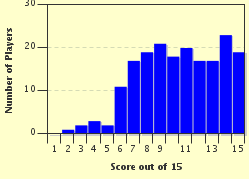Quiz Answer Key and Fun Facts
1. In Herman Melville's "Moby-Dick" the whale and Captain Ahab are seen as mortal enemies through a prior confrontation, but what was unusual about the whale that Ahab pursued relentlessly?
2. A.A. Milne's creation "Winnie-the-Pooh" was the companion of which little boy?
3. In P.G. Wodehouse's books about "Jeeves and Wooster" we often hear Wooster referred to as Bertie by his friends, but normally Jeeves is just called by his surname. What is Jeeves' first name?
4. Enid Blyton's children's creations "Noddy and Big Ears" are constantly plagued in Toyland by a pair of naughty goblins who take advantage of Noddy's good nature by playing tricks on him. What are their names?
5. "Romeo and Juliet" is one of Shakespeare's most performed and best-loved plays. The intensity of young love hampered by the family feud between the Montagues and Capulets forms the background to this tragedy. In which city is the play set?
6. Sherlock Holmes is normally associated with Doctor Watson; however, his arch enemy was the master criminal Moriarty. Where in Switzerland did they have their ultimate confrontation and plunge to their deaths?
7. Which identical twins decided "to have a battle" because one had spoilt the other's "nice new rattle"?
8. In Dickens' "Oliver Twist" what is the name of the dog that is inseparable from Bill Sikes and whose loyalty leads to Bill's demise?
9. Adam and Eve were obviously an integral part of the Old Testament of The Bible but in which Seventeenth Century narrative poem by John Milton are they also major characters?
10. In Daniel Defoe's "Robinson Crusoe" how does Crusoe find out that the man he eventually calls "Friday" is also on the island where he is marooned?
11. In which pointless exercise did Cervantes' Don Quixote and his sidekick Sancho Panza indulge themselves?
12. In which city do Colin Dexter's detective Inspector Morse and his colleague Lewis operate?
13. Svengali is a character in a George du Maurier novel of 1894 mainly set in Paris. What is the name of the eponymous heroine who he controls through hypnotism?
14. The Brothers Grimm were two German academics who brought together folk and fairy tales in the nineteenth century. Although they are seldom referred to individually, what are their given first names?
15. Which of Agatha Christie's regular detective characters sometimes has an investigative partner called Arthur Hastings?
Source: Author
baker13
This quiz was reviewed by FunTrivia editor
agony before going online.
Any errors found in FunTrivia content are routinely corrected through our feedback system.

